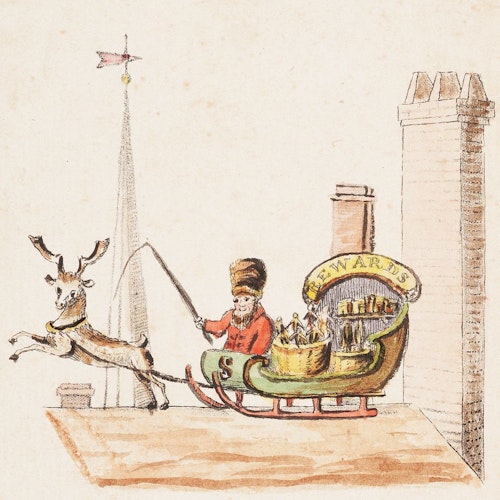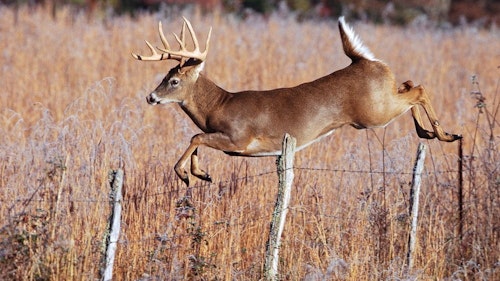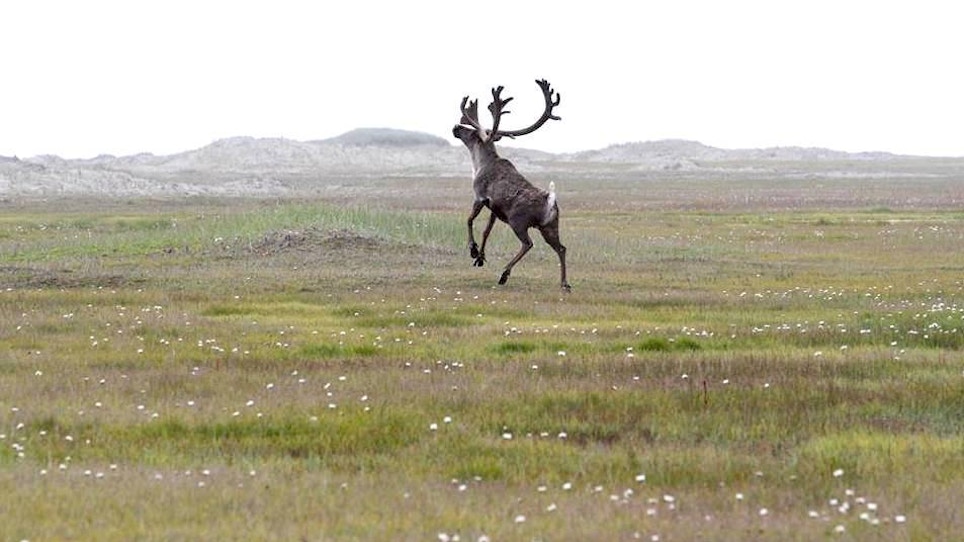Caribou taking off at Bering Land Bridge National Preserve. Photo: Katie Dunbar (National Park Service)
Five days before Christmas, the National Park Service (NPS) posted a question about a reindeer’s ability to fly, along with an image of a leaping caribou. The social posts also cited similarities between reindeer and caribou.
In the agency’s Instagram post, which started by saying, “someone call Santa, I’m about to sleigh this flying thing,” the NPS asked what must have been a rhetorical question, “do reindeer really know how to fly?”
But the federal agency moved past that question — without offering an answer — to quickly draw comparisons between reindeer and caribou, two very similar animals.
“Caribou and reindeer are almost identical, sharing the same genus and species name,” according to the NPS post. “It wasn't until about 2,000 years ago that they were domesticated in Eurasia and became what we know as the modern day reindeer. Originally, caribou populated Alaska long before reindeer were introduced from Siberia by a missionary in 1892.”
Although they look almost identical, the NPS says caribou have longer legs and leaner bodies than reindeer, while reindeer are, “typically more sedentary, have thicker fur, and some may have red nose. (According to one song).”
It’s true one song and countless movies and television series offer accounts of one reindeer, Rudolph, who is said to have a red nose. Yet, the University of Alaska Fairbanks (UAF) published a more detailed resource on the differences between reindeer and caribou, but a red nose was never cited in the university’s document as a distinguishing trait of some reindeer.

The UAF resources on reindeer also includes a list of traditional uses of reindeer. Flying or pulling Santa’s sleigh in flight, however, were never mentioned. Instead, the university’s list includes milk. That’s right, reindeer was once a source of milk, used to make butter and cheese. The reindeer’s back sinew was used to make thread. And the reindeer’s hair can be eaten. It’s a practice that has saved some groups from starvation.
This is remarkable, sure, but by most standards it doesn’t hold a candle to flying or helping deliver billions of gifts on Christmas Eve.
Yet for nearly two centuries, passed from generation to generation, there’s this resilient lore that persist, the lore of flying reindeer. The first reference to Santa’s flying reindeer appeared in Old Santeclause with Much Delight, an illustrated children’s poem published in New York in 1821.
Fast-forward to 2006, and we have the most recent documented research on flying reindeer. According to the Oregon Zoo and its study, “Scientific Theory and Flying Reindeer,” the ability to gather scientific data on a phenomenon that only occurs once every 365 days is exceedingly difficult.
“For animal behaviorists, you have very limited opportunities to collect data,” said Oregon Zoo Director Tony Vecchio. “Stories of flying reindeer have circulated for years, but the number of actual sightings are quite low.”
Vecchio did acknowledge that, while sightings are low, there are many accounts of reindeer and the sound of reindeer hooves on the roofs of homes, often occupied by children. Vecchio’s research has given way to a theory that might explain the phenomenon.
“What my investigations are showing is, what these reindeer are doing is actually extended leaping,” Vecchio says. “They can leap incredible distances.”
The Oregon Zoo director believes that what may appear from the ground-level to be flying is in fact something quite different.
“Somebody standing on the ground who sees the reindeer coming into their field of view in the air and then leaving their field of view in the other direction, miles away, still in the air, (thinks) that they must be able to fly,” he says. “But, in fact, it’s just one incredible jump.”
In light of this research, take a second look at the image posted by NPS on the agency’s social feeds just five days Christmas Day. The caribou in the photo, which is also featured in this article, is making one incredible jump.
Given that reindeer are members of the Cervidea family — they’re deer — the theory of extended leaping begins to make sense, at least to many whitetail deer hunters in the U.S. who are, by nature, students of deer biology.
As avid hunter and outdoor writer Mark Kayser wrote in an article published to Grand View Outdoors, most deer can clear a 6-foot fence, some may be able to jump as high as 8-feet. And according to Leonard Lee Rue III’s book The Deer of North America, the distance a deer can cover by jumping is substantial. “The longest span between tracks that I have personally measured was a little over 26 feet (8 meters),” Rue says.
Rue also notes of a measurement from another individual of a whitetail running down a slight grade that cleared a 29-foot horizontal distance. And renowned wildlife photographer and whitetail expert Charles Alsheimer observed, measured and then wrote about a buck being run off by another that cleared a 35-foot span.

So Does the Theory of ‘Extended Leaping’ Mean Reindeer Don’t Fly?
Now there may be feelings of befuddlement setting in. You might feel the lore of Santa’s eight flying reindeer slipping away. And, if so, what does this say about Santa himself?
Here’s the thing. Often modern people find themselves cornered by an insistence that things must be either this or that. Maybe the notion of flying reindeer isn’t an either/or proposition. Perhaps, instead, the fact is this: All flying is essentially a series of extended leaps. So if it’s true that reindeer are only participating in a series of incredible jumps, who is to say that’s not, in fact, what flying actually is?
Flying isn’t infinite. Superman lands. And consider the modern experience of air travel. A plane’s “leaps” are long, but so are their layovers. Many families are traveling for the Christmas holidays and they’ll each experience this phenomenon of travel. And when you’re grounded and waiting to take off again, just remember you’re doing as the reindeer do.
And that’s a fine thing. Some even call it flying.






